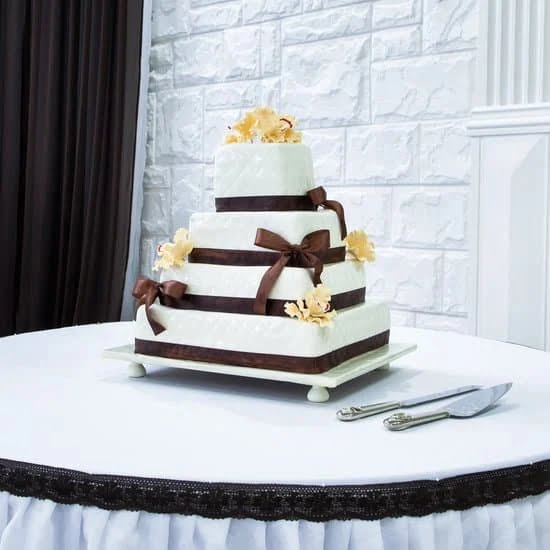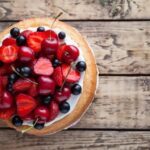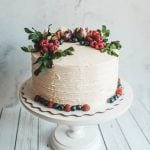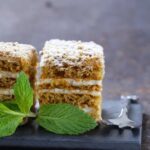Cake decorating is a delightful art form that allows bakers to transform simple baked goods into stunning edible creations. One medium that has gained immense popularity in recent years is modeling chocolate.
Whether you’re a professional cake decorator or a home baker looking to elevate your creations, understanding what modeling chocolate is and how it can be used is essential. In this article, we will delve into the sweet world of cake decorating with modeling chocolate, exploring its definition, history, and various applications.
Modeling chocolate, also known as chocolate clay or candy clay, is a versatile and pliable material made from combining melted chocolate and corn syrup or glucose syrup. This unique concoction results in a smooth, flexible consistency that can be molded and shaped into intricate designs. Originally developed by pastry chefs to create show-stopping cakes and decorations, modeling chocolate has significantly transformed the realm of cake decorating.
To fully appreciate the wonders of modeling chocolate, it is important to know about its fascinating origins. The concept of using chocolate as an artistic medium dates back centuries to ancient civilizations like the Aztecs who revered cocoa beans for their divine qualities. Fast forward to modern times; professional bakers began experimenting with different techniques and ingredients to develop new ways of utilizing chocolate for cake decorations. And thus, modeling chocolate was born.
In the following sections of this article, we will explore in detail the magical properties of modeling chocolate and how it can bring creativity and uniqueness to any cake decorating project. From learning about its key ingredients that make it so special to discovering various techniques for shaping and sculpting lifelike figures with ease, you’ll find all the information you need to become an expert in working with modeling chocolate.
So grab your apron and let’s embark on this sweet journey together.
Unraveling the Ingredients
Modeling chocolate is a unique cake decorating medium that sets itself apart from other alternatives due to its distinctive ingredients. This section will dive into what makes modeling chocolate so special and examine its key components. The ingredients used in making modeling chocolate include chocolate and corn syrup, which work together to create a pliable and versatile material for cake decorators.
The primary ingredient in modeling chocolate is, of course, chocolate. It is crucial to use high-quality chocolate when making modeling chocolate as it directly affects the taste and texture of the final product. Dark or milk chocolate can be used depending on personal preference, but it should have a high cocoa content for the best results. The more cocoa solids in the chocolate, the firmer the finished modeling chocolate will be.
Corn syrup is another essential component in creating modeling chocolate. Corn syrup helps bind the melted chocolate together and gives it flexibility when cooled. It also adds a touch of sweetness to counterbalance the richness of the chocolate. In some recipes, liquid glucose may be used as an alternative to corn syrup.
When compared to other cake decorating mediums such as fondant or gum paste, modeling chocolate offers several advantages. One significant advantage is its taste – unlike fondant which can be overly sweet or gum paste which has no flavor, modeling chocolate has a rich, chocolaty taste that complements any cake flavor. Additionally, since it is made primarily from real chocolate, it melts in your mouth instead of being chewy like fondant or gum paste.
Moreover, modeling chocolate provides greater flexibility for sculpting detailed decorations or figures due to its pliability. Fondant may crack or tear when trying to achieve intricate designs, while gum paste dries quickly and becomes brittle even before completing the desired shape. Modeling chocolate allows decorators to take their time and create delicate details without worrying about them drying out too fast.
In summary, what makes modeling chocolate so special is the combination of high-quality chocolate and corn syrup that creates a delicious and pliable material perfect for cake decorating. Its taste, flexibility, and versatility set it apart from other mediums commonly used in cake decoration. With modeling chocolate, decorators can not only achieve exquisite designs but also provide a pleasant surprise to their clients with its delectable flavor.
The Versatility of Modeling Chocolate
The versatility of modeling chocolate allows cake decorators to bring their creative visions to life, from simple shapes to intricate designs. Modeling chocolate can be molded and shaped into a wide variety of forms, making it an essential tool for cake decorators looking to add dimension and detail to their creations.
One of the key techniques used in modeling chocolate is creating basic shapes. By following a step-by-step guide, beginners can learn how to shape modeling chocolate into spheres, cones, cylinders, and more. These basic shapes serve as building blocks for more complex designs and can be combined to create a wide array of cake decorations.
Once decorators have mastered the art of shaping basic forms with modeling chocolate, they can delve into creating more intricate designs. The pliability and malleability of modeling chocolate allow for the sculpting of detailed figures and cake toppers. From cartoon characters to lifelike animals, any design is possible with the right techniques and tools.
In order to achieve realistic textures and details with modeling chocolate, decorators employ various tips and tricks. Tools such as sculpting tools, silicone molds, and texture mats are often used in combination with modeling chocolate to enhance the intricacy of the design. Additionally, decorators may use techniques such as adding layers or using different colors of modeling chocolate to create depth and dimension.
| Techniques | Applications |
|---|---|
| Sculpting | Cake toppers |
| Molding | Embellishments |
| Carving | Custom decorations |
| Piping | Textured designs |
The versatility of modeling chocolate extends beyond cake toppers and intricate sculptures. Decorators can also use modeling chocolate to achieve painted effects on their cakes. By coloring the modeling chocolate with edible food coloring, decorators can create vibrant and multifaceted designs. This technique allows for a range of possibilities, from bold and abstract patterns to delicate watercolor-like effects.
Sculpting Edible Masterpieces
Using modeling chocolate for detailed cake decorations allows for the creation of edible masterpieces that are not only visually stunning but also lifelike. Sculpting with modeling chocolate offers a unique and versatile medium for cake decorators to bring their imagination to life. From realistic figurines to intricate details, this section will explore the art of sculpting with modeling chocolate and provide tips and tricks for achieving remarkable textures and details.
Sculpting Lifelike Figures
One of the key advantages of using modeling chocolate for cake decorations is its ability to be molded and shaped into highly realistic figures. Whether it’s animals, people, or objects, sculpting with modeling chocolate can create lifelike representations that can enhance any cake design. The pliability and texture of the chocolate make it ideal for capturing intricate details such as facial expressions, clothing folds, or even hair strands.
To start sculpting a figure using modeling chocolate, it is important to have a clear plan or reference image in mind. Begin by kneading the modeling chocolate until it becomes soft and malleable. Then, start by forming the basic shape of the figure, gradually adding more detail as you go along. Tools like sculpting tools, toothpicks, or even a small paintbrush can be used to create fine details in the figure.
Achieving Realistic Textures and Details
To achieve realistic textures and details when working with modeling chocolate, there are various techniques that can be employed. One technique is called embossing where you press different textured materials such as lace onto the surface of the chocolate to create intricate patterns. Another method involves using edible dusts or powdered food colors to add shading and highlighting effects on the sculpted figures.
When it comes to creating skin texture or fur-like details on animals, a technique known as stippling can be utilized. Stippling refers to repeatedly poking at the surface with a sculpting tool or toothpick to create small indents, resembling the texture of skin pores or fur strands. By varying the size and depth of these indentations, one can achieve a more realistic representation of the subject being sculpted.
By incorporating these techniques along with practice and patience, cake decorators can truly elevate their cake designs to new levels of artistry using modeling chocolate. The possibilities are endless, and sculpting edible masterpieces with modeling chocolate is a rewarding way to showcase creativity in cake decorating.
Painting with Chocolate
Exploring Different Methods of Coloring Modeling Chocolate
One of the unique features of modeling chocolate is its ability to be colored and transformed into vibrant hues. There are several techniques that can be used to add color to your modeling chocolate creations. One popular method is kneading gel or powdered food coloring into the chocolate while it is still in its pliable state.
This allows for a consistent and even distribution of color throughout the modeling chocolate. Another technique involves painting directly onto the surface of the finished modeling chocolate using edible food colorings, such as gel or powdered colors mixed with alcohol or lemon extract. This method allows for more intricate details and shading effects.
Inspiration for Using Painted Modeling Chocolate in Cake Decorating
Painting on modeling chocolate opens up a world of creative possibilities. You can use this technique to create realistic textures, patterns, and designs on your cake creations. For example, you could paint modeled flowers with vibrant colors, adding depth and dimension to each petal. You can also use painted modeling chocolate to replicate intricate lace designs on fondant-covered cakes, giving them an elegant touch.
In addition to replicating natural elements like flowers and lace, you can also use painted modeling chocolate to mimic other art forms such as watercolor paintings or abstract designs. The versatility of this medium allows for endless experimentation and the chance to truly showcase your artistic skills.
Tips for Successful Painting with Modeling Chocolate
When working with painted modeling chocolate, there are a few tips that can help ensure success. Firstly, make sure your modeling chocolate is thoroughly cooled and hardened before attempting to paint on it. This will prevent any smudging or melting during the painting process.
Secondly, it’s important to use edible food colorings specifically designed for use on modeling chocolate or other similar mediums. These types of food colorings have the right consistency and composition to adhere well to the surface of the modeling chocolate without causing any damage or compromising its texture.
Lastly, practice makes perfect. Experiment with different techniques and color combinations to find what works best for your desired effect. Don’t be afraid to mix colors or layer them for added depth and dimension. With time and practice, you’ll develop your own unique style and technique for painting with modeling chocolate.
By exploring various methods of coloring modeling chocolate and experimenting with different artistic techniques, you can bring your cake creations to life with a pop of color and flair. Painting with modeling chocolate offers a whole new level of creativity in cake decorating, allowing you to unleash your artistic abilities and create show-stopping cakes that are as beautiful as they are delicious.
Beyond Cake Toppers
Modeling chocolate is not limited to just creating cake toppers. Its versatility allows for a wide range of creative uses in cake decorating. In this section, we will explore some unconventional uses of modeling chocolate that can elevate your cake creations to the next level.
One unique application of modeling chocolate is in creating edible flowers. With its pliable texture and ability to hold intricate shapes, modeling chocolate can be formed into lifelike petals and blooms. Whether you want to decorate a wedding cake with delicate roses or embellish cupcakes with daisies, modeling chocolate provides a realistic alternative to traditional sugar flowers. These edible flowers not only add visual appeal but also offer additional flavor and texture to your cakes.
Another creative use for modeling chocolate is in making lace decorations. The smooth and malleable nature of modeling chocolate allows it to be rolled thin and cut into intricate designs resembling delicate lace patterns. These edible lace pieces can then be placed on cakes or cupcakes, adding an elegant touch to your creations. By experimenting with different shapes and designs, you can create unique and visually stunning effects using modeling chocolate lace.
Geometric patterns are also becoming increasingly popular in cake decorating, and modeling chocolate offers the perfect medium to achieve clean lines and precise shapes. By shaping and stacking different colored blocks of modeling chocolate, you can create geometric patterns that add a modern and sophisticated element to your cakes. From sharp angles to gentle curves, the possibilities are endless when it comes to incorporating geometric designs using modeling chocolate.
| Unconventional Uses | Examples |
|---|---|
| Edible Flowers | Roses, daisies, orchids |
| Lace Decorations | Intricate lace patterns on cakes or cupcakes |
| Geometric Patterns | Clean lines and precise shapes for a modern look |
Troubleshooting Modeling Chocolate
Modeling chocolate is a versatile and fun medium to work with in cake decorating, but like any artistic endeavor, it can come with its fair share of challenges. In this section, we will explore some common issues that may arise when working with modeling chocolate and provide step-by-step solutions to help troubleshoot these problems.
Issue: Cracking or Breaking
One common issue that decorators may encounter when working with modeling chocolate is cracking or breaking. This can be frustrating, especially when trying to create intricate details or sculpted figures. However, there are several solutions to help prevent this problem:
- Make sure your modeling chocolate has been properly kneaded and is at the right consistency before working with it. If it feels too firm or dry, try warming it up slightly in your hands or in the microwave for a few seconds.
- Avoid overworking the modeling chocolate as this can cause it to become dry and prone to cracking. Remember to take breaks if needed and allow the material to rest.
- If your design requires a large piece of modeling chocolate, consider adding a support structure underneath to prevent sagging or breakage.
- If a crack does occur, gently warm the area with your hands or using a heat gun on low heat. Then, apply a small amount of melted modeling chocolate or corn syrup onto the crack and press it together until it adheres.
Issue: Sticking to Surfaces
Another common issue faced by decorators is modeling chocolate sticking to surfaces such as countertops, molds, or tools. To avoid this problem:
- Use a non-stick surface such as a silicone mat or parchment paper when rolling out and shaping your modeling chocolate.
- Dust your work surface lightly with powdered sugar, cornstarch, or cocoa powder before placing your modeling chocolate on top.
- If your modeling chocolate starts sticking to your tools while sculpting or shaping, try dusting them with powdered sugar or cornstarch.
- If the modeling chocolate becomes too soft and sticky to work with, place it in the refrigerator for a few minutes until it firms up.
Issue: Color Fading
Sometimes, when working with colored modeling chocolate, you may notice that the colors fade or become dull over time. To help maintain vibrant colors:
- Ensure that you are using high-quality food coloring or gel paste specifically designed for coloring chocolate.
- Start with a small amount of color and gradually add more if needed. Adding too much color can affect the consistency of your modeling chocolate.
- Store your completed creations in a cool, dry place away from direct sunlight to prevent color fading.
- If you need to make a batch of colored modeling chocolate in advance, wrap it tightly in plastic wrap and store it in an airtight container or ziplock bag to minimize exposure to air and light.
By following these troubleshooting tips and tricks, decorators can overcome common challenges when working with modeling chocolate and create stunning cake decorations with confidence. With practice and patience, you’ll be able to perfect your skills and achieve professional-looking results every time.
The Future of Modeling Chocolate
The world of cake decorating is constantly evolving, and modeling chocolate is no exception. As cake decorators continue to push the boundaries of their creativity, new innovations and trends are emerging in the use of modeling chocolate. In this section, we will take a closer look at what the future holds for modeling chocolate in cake decorating.
One current development in modeling chocolate techniques is the use of molds. While traditionally, modeling chocolate has been shaped by hand, molds provide a more efficient and precise way to create intricate designs. With the availability of various silicone molds specifically designed for modeling chocolate, decorators can now easily make consistent shapes and patterns. From flowers to lace to geometric patterns, these molds offer endless possibilities for adding stunning details to cakes.
Another trend that is gaining momentum in cake decorating is the combination of different mediums with modeling chocolate. Cake decorators are experimenting with incorporating elements such as fondant or wafer paper into their designs alongside modeling chocolate.
This fusion of mediums allows for unique textures and effects that elevate the overall look of the cake. For example, a decorator may use fondant to create smooth surfaces or delicate ruffles while using modeling chocolate to sculpt lifelike figurines or add intricate details.
In addition to blending mediums, painting with colored cocoa butter has become a popular technique in cake decorating using modeling chocolate. This method allows decorators to add vibrant colors and artistic flair to their creations. By mixing edible food coloring with cocoa butter, decorators can achieve an array of shades and create beautiful painted effects on their modeled chocolate pieces.
As we delve further into the future of modeling chocolate in cake decorating, we anticipate advancements in both techniques and products. With growing interest and demand for elaborate and realistic cake designs, it is likely that manufacturers will develop new tools and accessories specifically tailored for working with modeling chocolate.
By staying up-to-date with innovations and trends in modeling chocolate techniques and products, cake decorators can continue to improve their skills and expand their creative horizons. The future of modeling chocolate in cake decorating is bright and exciting, offering endless possibilities for beautiful and unique cake creations.
Conclusion
In conclusion, modeling chocolate is a versatile and exciting medium that can truly elevate your cake decorating game. Throughout this article, we have explored the definition and origin of modeling chocolate, as well as its unique ingredients that make it so special. We have also delved into various techniques and applications, from creating basic shapes to sculpting intricate figures and adding color with painted modeling chocolate.
One of the highlights of using modeling chocolate in cake decorating is its ability to create detailed and lifelike cake toppers. With a little practice and the right techniques, you can achieve realistic textures and stunning details that will impress any recipient of your cake creation. Whether you are making animals, flowers, or other intricate designs, modeling chocolate provides endless possibilities for bringing your edible masterpieces to life.
Furthermore, modeling chocolate offers a wide range of creative uses beyond traditional cake toppers. From delicate lace patterns to striking geometric designs, you can use modeling chocolate to add an artistic flair to your cakes. The only limit is your imagination. Don’t be afraid to think outside the box and experiment with unconventional projects using modeling chocolate.
Frequently Asked Questions
What is the difference between chocolate and modeling chocolate?
The key difference between chocolate and modeling chocolate lies in their composition and consistency. Chocolate is typically made from cocoa solids, cocoa butter, sugar, and sometimes milk or other additives. It has a smooth, glossy texture when melted and solidifies into a firm but breakable form when cooled.
On the other hand, modeling chocolate is essentially a mix of melted chocolate and corn syrup or glucose syrup. This mixture results in a pliable modeling medium that can be shaped and molded into intricate designs. Unlike regular chocolate, modeling chocolate does not set hard; it remains semi-soft and flexible even after it cools.
How to decorate cake with modeling chocolate?
Decorating a cake with modeling chocolate can be an enjoyable and creative process. Firstly, ensure your cake is fully cooled to prevent the modeling chocolate from melting upon contact. Roll out the modeling chocolate on a clean, smooth surface using a rolling pin just like you would with fondant or pastry dough. Carefully transfer the rolled-out sheet of modeling chocolate onto the cake by gently draping it over the top surface.
Smooth out any air bubbles or wrinkles with your hands or a smoothing tool, gradually working from the center towards the edges of the cake. To shape or create specific decorations such as flowers or figurines, use your hands or sculpting tools to mold the softened modeling chocolate accordingly. You can also color the modeling chocolate using food coloring gels before shaping it to achieve desired hues for your decorations.
Does modeling chocolate dry hard?
Modeling chocolate does not dry hard like fondant or gum paste; instead, its consistency remains relatively soft even after it sets at room temperature or refrigeration. However, this pliability lends itself well to sculpting detailed decorations for cakes without becoming brittle or fragile.
While modeling chocolate won’t harden like other mediums commonly used in cake decorating, its malleability allows for more flexibility in terms of designing and arranging intricate elements on cakes while providing an edible alternative to fondant that some find more enjoyable to eat. It’s worth noting that the firmness of modeling chocolate can vary based on factors such as the percentage of chocolate used and the temperature at which it is stored or worked with.

Welcome to our cake decorating blog! My name is Destiny Flores, and I am the proud owner of a cake decorating business named Cake Karma. Our mission is to provide delicious, beautiful cakes for all occasions. We specialize in creating custom cakes that are tailored specifically to each customer’s individual needs and tastes.





